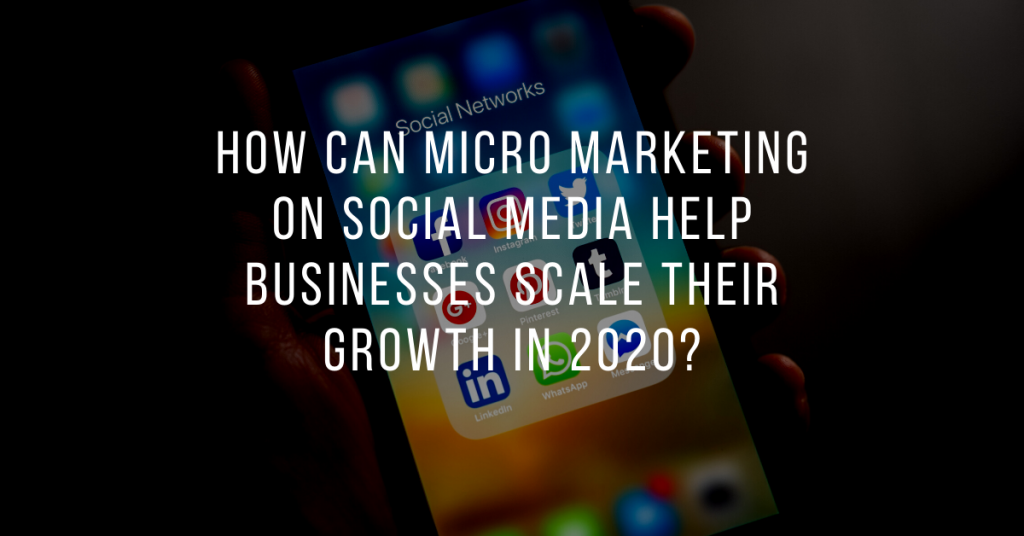
2020 is proving to be a challenging year for all business owners. With the corona pandemic pushing everyone indoors, it may appear that ecommerce would skyrocket with people spending a record amount of time online. But the insecure job market has got customers scared about what the future has in store. While some businesses are experiencing a fall in revenue, others are at risk of closing down.
It’s a well-known fact that businesses cannot exist without customers. So what can brands do if consumers are less inclined to purchase? Now that’s a question that’s been swirling in my head for some time.
The answer lies in micro marketing.
Brands can focus their efforts by targeting a specific group of people that are more likely to interact with them. Not only does this help strengthen brand identity and develop better relationships, but it’s also a great way to scale the business in these trying times. In fact, micro marketing is helping brands improve customer satisfaction, retention, loyalty, and much more.
What brands need to understand is that using social media can significantly improve the results. Why is that?
Well, that’s because micro-marketing techniques involve narrowly defining the target audience by a particular characteristic, such as gender, job title, age, geography, preferences, etc. Campaigns are then geared towards these specific groups. But a social media marketing strategy already has analytical tools that gather, analyze, and report essential metrics relevant to the brand. So it seems that it’s a match made in heaven.
All business owners now need to do is incorporate micro-marketing techniques through social media.
The effectiveness of micro marketing on social media
For businesses that are proactive about change, this is the way forward. Often, many turn to digital transformation guides to acquire digital marketing excellence which is a great thing. Another thing we can’t skip mentioning is that social media is proving to be the catalyst for the development of micro marketing.
To get a better understanding of what this is, I’ve decided to take inspiration from campaigns used by Coca Cola and Ford. Sure, these multinational companies probably have a considerable budget for ad spend, but that’s not what I’m interested in. I’m talking about the micro marketing techniques they are implementing to facilitate growth. Any business owner can apply them as well and get the same results, albeit not as dramatic as Coke and Ford!
And no, just so you know, they’re not paying me to write this blog. 🙂
Ok, let’s take a closer look, shall we?
1. Pumping brand loyalty
From the get-go, Coke built an image associated with joy and happiness. And as a multinational brand, it is now setting an example of how micromarketing can enhance brand loyalty.
Coca Cola remains one of the most vibrant product-focused communities on Facebook. So it’s no surprise that everything the brand does on social media aligns with the fan-first philosophy. In fact, it’s a hub dominated by the voice of the consumers that supports the brand’s marketing objectives. Coke encourages the community-building activities surrounding the brand. Consumers create, upload, consume, and comment on user-generated, brand-related content.
2. Optimizing the use of emerging innovations
But Coca Cola continues to look for ways to maximize their investments and grow profitability. And that allows the company to grow. By collecting and analyzing consumer data, it can produce research-based insights. More importantly, the company can then offer a unique appeal to specific customers or segments. Coke has put something new and innovative on the table for tech-savvy teens and millennials in the micro-market section. The company is investing in cashless payment vending solutions to these customers in order to increase sales and drive profits.
The Company developed the Student Card Acceptance program aimed for college and university students. The cashless technology was introduced to accept payment from mobile payment solutions (Android Pay and Apple Pay), debit cards, and credit cards. Now, Coca Cola’s North America vending fleet has more than 100,000 vending machines that support this technology.
3. Leveraging data
Everything is important about your consumer. The evolution of consumer marketing has allowed more data to be readily available to business owners. And since a large percentage of consumers are on social media, brands can utilize consumer data to identify purchasing trends and patterns. Businesses can accelerate growth and expand as opportunities arise.
Like any other brand, Coca Cola knows the wealth of information that is hidden inside each transaction, from the time of day to the type of payment type to additional products purchased. Recent data highlighted that the highest percentage of beverage, meal, and snack sales is between 10 a.m. and 2 p.m.
More importantly, the brand identified that when an average customer buys a sandwich and soft drink, there’s almost a 60% chance that he’ll buy chips. Micromarketing to incentivize the purchase of chips can help drive up sales. Moreover, exclusive deals can help boost sales during the lowest traffic times (2 a.m. to 6 a.m.). Hence the marketing of midnight fast food deals that offer drink combos.
4. Enhancing customer satisfaction
Businesses need to aim at offering services and products that excel customer expectations. It’s one way to keep them hooked to the brand and keep them coming back. Customer satisfaction is achieved when customer expectations of a product or service are met.
By incorporating micro marketing into their operations and activities, businesses can align their marketing efforts with a particular audience. Therefore, they should know what’s trending on social, from memes to music to videos. Quite recently, Coca Cola homed in on the fanfare and buzz surrounding Stranger Things.
Recognizing the power of micro marketing on social media, it brought in a ’80s makeover ahead of the new season. But in addition to the organic and paid social media activity, the brand took things to the next level. It partnered with Netflix and launched a Stranger Things-themed pop-up arcade in London. Not only did this allow fans to be a part of the launch, but it was also an excellent opportunity for user-generated content to be posted on the brand’s page.
5. Magnifying reach and brand awareness
The popularity of social media has made it an ideal platform for brands to create brand awareness. Used in the right way, businesses have been able to draw attention to their products, services, motives, promotional offers, etc. But the most significant change has arrived with the help of micro-influencers.
By combining the power of these brand ambassadors with the potential behind micro marketing, businesses can reap exponential results. And that’s precisely what Ford Motors did with the launch of its Ford Fiesta.
Instead of utilizing typical advertising to create a hype of their new model, the company loaned European-spec Fiestas to 100 young social media users for six months. They were able to generate a buzz about the automobile by telling stories on various social platforms and spreading the word through peer-to-peer conservations.
With this non-traditional approach, Ford was able to align the essence of the car with the general public. The Fiesta movement (as Ford called it) saw an exemplary amount of success over the six-month program, delivering more than 10 million media impressions without a single dollar of paid media spend.
Attention on social media included a million YouTube video views, more than 3.7 million estimated Twitter impressions, and 740,000 Flickr photo views. Ford claimed that brand-name recognition of the not-yet-available Fiesta reached 80%.
More importantly, there was an impressive increase in the brand’s interest when the next model was released. 97% of these people didn’t even drive a Ford at the time.
Final thoughts
Micromarketing is a concept that can be adopted by all types of businesses. In fact, often, brands don’t even require plenty of resources. Merely knowing how to incorporate it into social media is adequate.
As an effective marketing tool, it’s allowing businesses to make themselves more appealing to specific consumer segments. In 2020, that just maybe what you need to stay on top of your game.




